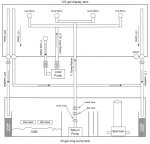Since this is a revised plumbing design, my suggestions may contradict what others have already told you. Nevertheless, here are my thoughts:
1) As already mentioned, it is not a good idea to rely on check valves. I would add anti-syphon holes to your sump returns. This may be difficiult since you are bringing the returns through the back of the tank and under water. You could possible add a 1/4" bulkhead to the top of the return lines and run a 1/4" tube upward over the back of the tank so that it exits into the tank above the water line.
2) I would add a valve to control the flow from the 0.5" standpipe that feeds the left side of the sump.
3) Your unions sholud be between the pump and the ball valves on the closed loop.
4) I would double the number or size of the intakes for the closed loop. You want the flow rate (and the suction force) going through the intakes to be low, much lower than going out through the returns.
5) You should be aware that the portion of the sump where your return pump sits is separated from the rest of the sump by the vertical baffles. That means that evaporation will lower the water level of the pump area only, and since this is a relatively small area/volumn, you will get large and relatively quick fluctuations in the water level in this area. To reduce this problem, you may want to lower the top of the baffle adjacent the DSB, and move the baffles on the right side much closer to the skimmer.
6) Remember, you want to maintain a water level in your sump that is low enough to accomodate all the water in circulation when the return pump shuts down. This is often a lot more water than you might expect. Lowering the water will also help to control salt creep and splashing.
FWIW, I have designed, re-designed, modified, and re-modified sumps for tanks from 65 to 400 gallons more times than I like to admit.
Mike






